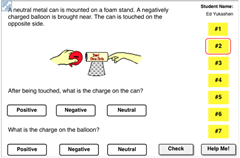 Name That Charge Activity
Name That Charge Activity
Resource:
Name That Charge Interactive
Grade Level: High School
Description:
This activity targets student understanding of charging methods, including induction, friction, and conduction. It’s intended for use in the latter stages of a learning cycle on charge interactions. Students interactively respond to 7 questions, randomly generated from a databank of 28 questions on charging. Immediate feedback is provided and learners earn stars for correct responses. Questions were intentionally designed to be highly challenging to high school learners, with extra support available by clicking the “Help” button.
This activity aligns with the three dimensions of the Next Generation Science Standards in the manner described below:
| Types of Interactions (HS-PS2.B.3): Attraction and repulsion between electric charges at the atomic scale explain the structure, properties, and transformations of matter, as well as the contact forces between material objects. |
In the Name That Charge interactive, students ponder a variety of scenarios involving interacting objects of positive, negative, and neutral charge. In some cases, the scenario involves a system of multiple objects. The activity is a formative assessment that asks learners to analyze seven electrostatic charging situations to determine the charge that each object would acquire as the result of interaction. |
| Cause and Effect – Grades 9-12: Cause and effect relationships can be predicted for complex natural and human designed systems by examining what is known about smaller scale mechanisms within the system. |
Cause and effect relationships are explicitly addressed as students consider what happens when objects of opposite charge are brought in proximity or in contact with each other. By viewing the animations, learners can visualize the migration of electrons that can be predicted in certain charge interactions. Similarly, they consider the interactions between neutral and charged objects in the process of induction. |
| Developing and Using Models – Grades 9-12: Develop or use a model based on evidence to illustrate the relationships between components of a system. |
Success with the Name That Charge Interactive demands that students rely on well-constructed mental models regarding charge and their interactions with other charges. Students must understand that opposites attract, likes repel and any type of charged object will attract a neutral object. Students must also know that electrons are free to move through conducting materials but not through insulating materials. Put these models together, students will be able to work through the seven situations with ultimate success. A Help button leads students to situation-specific information that uses these models to help students think through the situation. |
Associated Reading from The Physics Classroom
Other Supporting Pages at The Physics Classroom:
- The Curriculum Corner: Charging by Friction; Insulators, Conductors, and Polarization; Charging by Conduction and Grounding; Charging by Induction
View Infographic.
(Coming Soon)
Search the NGSS Corner
Maybe you're looking for something really specific that pertains to a desired topic and emphasizes one or more of the listed NGSS dimensions. Why not try a search of this section of our website? Simply select from one or more of the pull-down menus and click Search. This page will reload and a collection of possibilities will be displayed in this section of the page and sorted by relevancy.